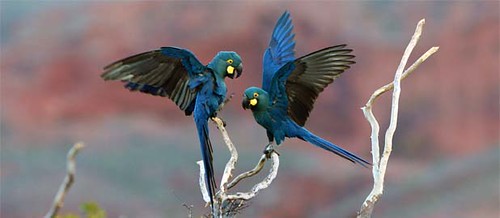Rare Blue Parrot Back from the Brink of Extinction
 Tuesday, June 23, 2009 at 12:34
Tuesday, June 23, 2009 at 12:34  Photo: Lear's Macaw pair by Ciro Ginez AlbanoThe Lear’s Macaw, a striking blue parrot found in northeastern Brazil, has been downlisted from Critically Endangered (the highest threat category) to Endangered as a direct result of conservation action, revealed the 2009 update to the IUCN Red List of Threatened Species.
Photo: Lear's Macaw pair by Ciro Ginez AlbanoThe Lear’s Macaw, a striking blue parrot found in northeastern Brazil, has been downlisted from Critically Endangered (the highest threat category) to Endangered as a direct result of conservation action, revealed the 2009 update to the IUCN Red List of Threatened Species.
The current population of Lear’s Macaw is estimated to be 960 birds, up from fewer than 100 birds in 1989. American Bird Conservancy and its Brazilian partner Fundação Biodiversitas have worked to save the macaw’s primary nesting and roosting cliffs, and together have purchased and protected nearly 4,000 acres of habitat to help assure the species’ survival.
“The fight to save Lear’s Macaw is far from over, but the news that it is being downgraded from Critically Endangered to Endangered is a clear indication that hard work is paying off,” said George Fenwick, President of American Bird Conservancy. “The overall picture for birds throughout the Americas and the rest of the world continues to be a great cause for concern, but the macaw serves as a shining example of what we can achieve when focused conservation action is backed up by broad cooperation and the required resources.”
Biodiversitas began working to save Lear’s Macaw in 1989. The macaw has suffered at the hands of illegal bird traders, and is further threatened by grazing by goats that prevents the regeneration of new licurí palms, the seeds and fruits of which form the macaw’s primary food source. Fires set to create pasture for cattle farmers have also contributed to loss of habitat.
In 1991, Biodiversitas created the Canudos Biological Station, then a 321-acre reserve, to protect core Lear’s habitat. In 2007, American Bird Conservancy raised the funds needed to dramatically expand the reserve, and just this year, the groups managed to secure a critical inholding to consolidate reserve lands. At least 700 of the remaining Lear’s Macaws are at Canudos.
“Since purchasing the land with the generous support of multiple donors, American Bird Conservancy and Biodiversitas have concentrated on reducing illegal trapping and protecting the nesting and roosting areas from disturbance by renovating and expanding the reserve’s guard station, which helps with round-the-clock protection for the birds,” said Gláucia Drummond of Fundação Biodiversitas. “Thanks to a recent grant from the Jeniam Foundation, the building is being renovated to better accommodate visiting scientists and birders interested in observing and studying the macaws.”
American Bird Conservancy and Biodiversitas are now planning licurí reforestation, and will be working with local landowners to establish the best plan for protecting young saplings from goats.
News from the IUCN for New Zealand’s Chatham Petrel was also good, and it was downlisted from Critically Endangered to Endangered. Unfortunately, the report also uplisted the Hooded Grebe to Endangered, and the newly discovered Gorgeted Puffleg , the Medium Tree-Finch (one of Darwin’s finches from the Galapagos), and the Palila (a Hawaiian honeycreeper), to Critically Endangered. A total of 1,227 bird species (12 percent) are now classified as globally threatened with extinction (includes Critically Endangered, Endangered, and Vulnerable). Of those, 192 are considered Critically Endangered.
 Anodorhynchus leari - Lear's Macaw | in
Anodorhynchus leari - Lear's Macaw | in  Conservation
Conservation 
